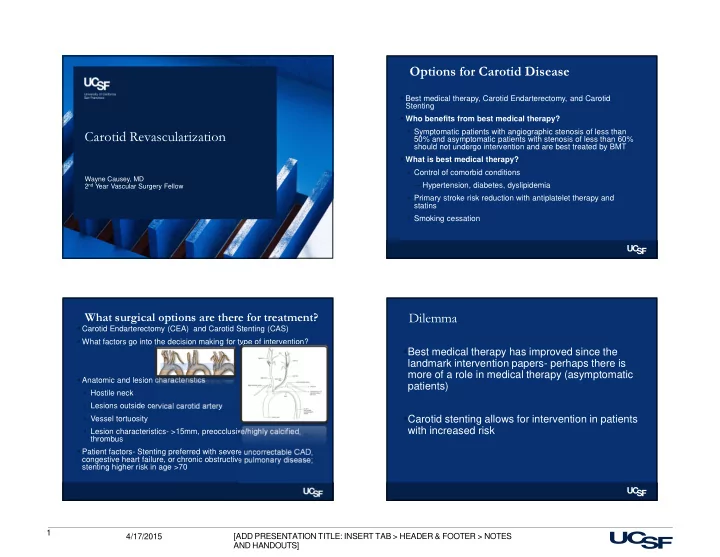

Options for Carotid Disease � Best medical therapy, Carotid Endarterectomy, and Carotid Stenting � Who benefits from best medical therapy? • Symptomatic patients with angiographic stenosis of less than 50% and asymptomatic patients with stenosis of less than 60% Carotid Revascularization should not undergo intervention and are best treated by BMT � What is best medical therapy? • Control of comorbid conditions Wayne Causey, MD 2 nd Year Vascular Surgery Fellow ‒ Hypertension, diabetes, dyslipidemia • Primary stroke risk reduction with antiplatelet therapy and statins • Smoking cessation What surgical options are there for treatment? Dilemma � Carotid Endarterectomy (CEA) and Carotid Stenting (CAS) � What factors go into the decision making for type of intervention? � Best medical therapy has improved since the landmark intervention papers- perhaps there is more of a role in medical therapy (asymptomatic � Anatomic and lesion characteristics patients) • Hostile neck • Lesions outside cervical carotid artery • Vessel tortuosity � Carotid stenting allows for intervention in patients with increased risk • Lesion characteristics- >15mm, preocclusive/highly calcified, thrombus � Patient factors- Stenting preferred with severe uncorrectable CAD, congestive heart failure, or chronic obstructive pulmonary disease; stenting higher risk in age >70 1 4/17/2015 [ADD PRESENTATION TITLE: INSERT TAB > HEADER & FOOTER > NOTES AND HANDOUTS]
CT Angiogram Case Presentation � 77M presented to the emergency department � High grade left proximal ICA with transient right hand weakness for 6 hours lesion (>90%) � Neurology emergently evaluated him and during � Not circumferential calcium that time, his hand weakness resolved � Ultrasound confirmed this � Admitted to the neurology service finding with string sign � Neurology ordered a CT head (no bleeding or � Right side with 50% lesions) and a CTA of the head an neck stenosis When would you offer this patient an What is the optimal timing of CEA in a intervention? symptomatic patient? Symptomatic (TIA) high grade stenosis. � In patients with stroke or TIA, intervention should be performed within 2 weeks unless there are contraindications to intervention 59% A. A: Emergently • Major contraindications are intracranial hemorrhage and massive B. B: Next Day stroke C. C: Within 2 weeks 32% D. D: Within 6 weeks E. E: Wait more than 6 weeks 9% 0% 0% 2 4/17/2015 [ADD PRESENTATION TITLE: INSERT TAB > HEADER & FOOTER > NOTES AND HANDOUTS]
Aorta- Done for Evaluation of Medical History 5.5cm AAA � EF 20-25% � Stress test- significant coronary artery disease, EF 20%, fixed perfusion defects � Also has a 5.5cm infrarenal AAA � No prior stroke like symptoms Transcervical How would you manage this patient? Carotid Stent A. A: Carotid endarterectomy under general anesthesia � Surgical exposure of the proximal Common B. B: Carotid endarterectomy under local anesthesia Carotid artery C. C: Transfemoral Carotid Stent 47% D. D: Transcervical Carotid Stent � Sheath placed in the distal CCA E. E: Best medical therapy 33% � Obtained the following angiogram 10% 10% 0% 3 4/17/2015 [ADD PRESENTATION TITLE: INSERT TAB > HEADER & FOOTER > NOTES AND HANDOUTS]
What sized stent would Post Operative Course you use? � Postoperatively he did well without complication 50% and was discharged on POD#2 A. A: Tapered uncovered stent 10- 8mmx40mm � POD4 at home had tremor in right hand that B. B: Tapered uncovered stent 9- 29% lasted 15 minutes (unreported) 7mmx40 21% � POD14 had 2 episodes of right hand tingling and C. C: Straight covered stent numbness lasting 15 minutes each and resolving- 8mmx5cm admitted, started on heparin � Unrevealing CTA of head and neck � MRI/MRA- No acute intracranial hemorrhage, mass effect, or large vascular territory infarct Lesion length 2cm Postoperative Course How would you manage this patient? � POD 15 awoke from sleep with tingling in right A. A: Continue therapeutic anticoagulation bridging to coumadin hand that resolved after positional change B. B: Emergent cerebral angiography 63% C. C: Repeat CT angiogram of the head D. D: Dual antiplatelet therapy � Next morning had weakness and discoordination E. E: Transcranial doppler in right hand with right sided perioral numbness 22% 7% 7% 0% 4 4/17/2015 [ADD PRESENTATION TITLE: INSERT TAB > HEADER & FOOTER > NOTES AND HANDOUTS]
Post Vasospasm Course � Treated medically for vasospasm (nimodipine) • Intraarterial verapamil • Nimodipine 30q4 • 4 days later switched to verapmil 80q8 • Discharged 7 days after last angiogram (1mo postop) on 180mg verapamil extended release for 21 days ‒ Dual antiplatelet therpy ASA 325/clopidogrel 75 � No further neurologic deficits or events 5 4/17/2015 [ADD PRESENTATION TITLE: INSERT TAB > HEADER & FOOTER > NOTES AND HANDOUTS]
Recommend
More recommend